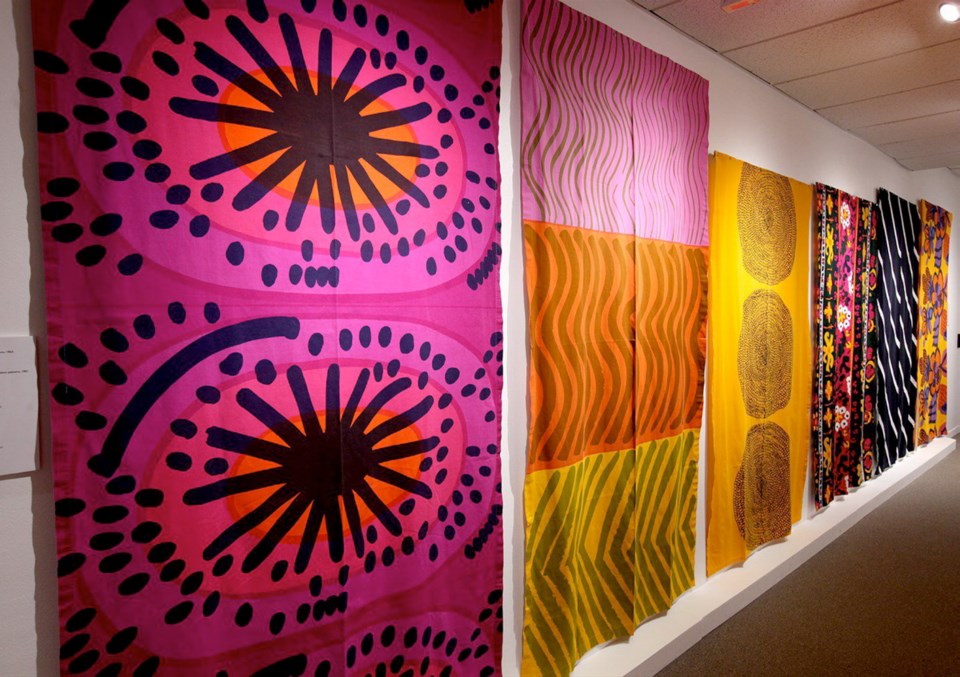You might not recognize the name Marimekko. But its iconic poppy print will no doubt look familiar.
Marimekko is the Finnish textile and fashion company that achieved international fame in the 1960s and ’70s with its big, bold screen prints. One of the brashest and most popular was Unikko, a stylized poppy image created in 1964.
The unmistakable Marimekko style — typically primary colours and pop-art-style graphics — is now brightening the Art Gallery of Greater Victoria. Marimekko, With Love is an exhibition from Toronto’s Textile Museum of Canada. It offers vintage dresses, bolts of fabric, catalogues, photographs, letters, telegrams and video displays.
Marimekko (which translates as “Mary’s dress”) was founded in Helsinki in 1951 by designer Armi Ratia. The company’s patterns and prints — a radical switch from duller colours prevalent in 1940s fashions — offered a post-war burst of colour and confidence. And in contrast to the tailored, form-fitting women’s clothing of the preceding decade, Marimekko dresses were loose and comfortable, says Shauna McCabe, executive director of the Textile Museum of Canada and the show’s curator.
The bulk of the exhibition is from the archives of Karelia, a design store in Toronto established in 1959 by architect-designer Janis Kravis. In North America, the other pioneering Marimekko distributor was Design Research, founded in 1953 in Cambridge, Massachusetts, by architect Benjamin Thompson.
Karelia, which had sole Canadian rights to import Marimekko, soon became a hub for Toronto’s hipster intelligentsia. For both Karelia and Design Research, the focus was using design in daily life. As well as fabrics and clothing, the stores carried products ranging from furniture to kitchenware.
This philosophical approach reflected Ratia’s own vision for Marimekko as not just a textile/fashion company but a democratizing social force.
“I don’t really sell clothes,” she once declared, “I sell a way of living.”
Says McCabe: “Everything was about design. It wasn’t simply making products. It was changing how people lived.”
Ratia envisioned her primary customer as the independent, confident “Mari-girl” (as well as women’s fashions, Marimekko made clothing for men and children). Inspired by Marshall McLuhan’s notion of the global village, her concept even extended to creating the Mari-village. This was to be a utopian community of pre-fabricated homes for Marimekko workers and their families. A prototype dwelling was constructed in 1966; however, the Mari-village was never built.
Marimekko’s popularity in Canada and the United States soared in the mid-’60s after Jacqueline Kennedy posed on the cover of Sports Illustrated in a red Marimekko dress. Vogue, Harper’s Bazaar and the New York Times spread the word on the new fashion.
“And then it blew up,” McCabe said. “Everyone wanted it.”
The Marimekko style was tremendously influential. McCabe notes the company’s early designs predate pop art, which first emerged in the mid-1950s and offered a similar boldness. “I wouldn’t say [Marimekko] was even an influence on pop art. It was just in the air, a changing esthetic. It was about colour and graphic and visual impact,” she said.
Some Marimekko designs were influenced by Finnish folk art. Sometimes the prints reflected images from nature. Typically, models for the clothing were photographed in a rural setting.
Although often associated with 1960/70s fashion, Marimekko is still popular today — its patterns can be seen on everything from credit cards to running shoes. The line is carried by stores all over Canada. Marimekko Vancouver offers a full line of products. In Victoria, Marimekko is sold by Leka Design on Fort Street.
Toronto’s Kravis (who lectured on Marimekko at the AGGV earlier this month) and Ratia became close friends, socializing with each other’s families. Part of their affinity may lie in the similarities between the two countries, McCabe suggests.
“Finland’s very like Canada. And a lot of things like this can only happen on the margins, and in marginal places, where you’re inventing out of thin air to a degree. A lot of invention happens on the margin and moves to the centre.”
The affection between Kravis and Ratia is reflected in correspondence on display at the Victoria exhibition. Her letters and telegrams are almost always signed “Love, Armi.”
“That’s where the title of the exhibition comes from, Marimekko, With Love. Because it was so much more than just a business,” McCabe said.
achamberlain@timescolonist.com
What: Marimekko, With Love
Where: Art Gallery of Greater Victoria
When: To May 3
Admission: $11, $13 ($2.50 for youth, free for children under five)
